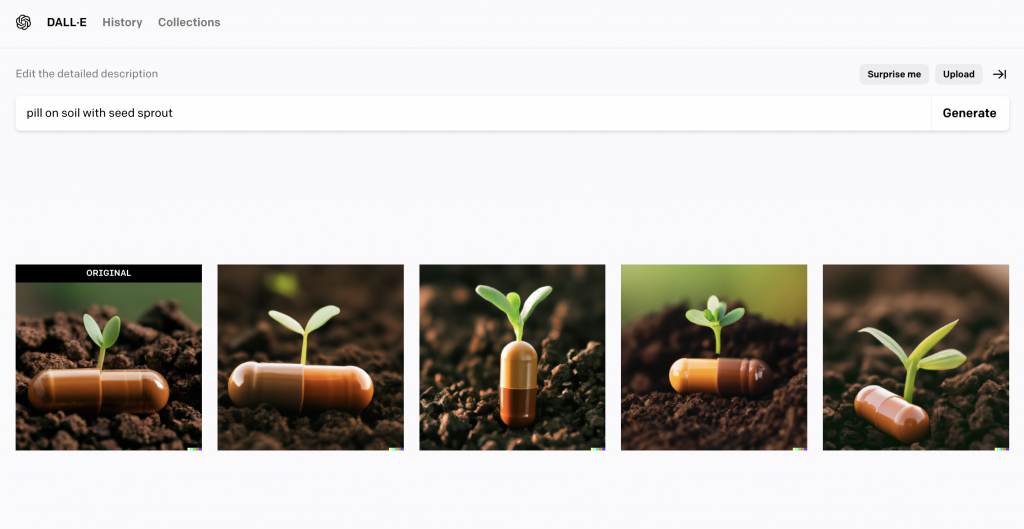Scenario Prompt
This week’s task involved writing a scenario based on a prompt generated through a version of Situation Lab’s (n.d.) game, The Thing From The Future.
Describe or narrate a scenario about a pill found a few years into a future in which society as we know it has come apart. Your description should address issues related to the government and elicit feelings of disgust.
Scenario
Reflection
When thinking of a scenario that could “elicit feelings of disgust” and address “issues related to the government” in a world “where society has come apart”, the climate crisis was one of the first issues that came to mind. At first, this seemed like an interesting prompt and I decided to run with it, keeping in mind Dunne & Raby’s (2013) suggestion that speculative scenarios “are by necessity provocative, intentionally simplified, and fictional” (p. 3). However, while working through the the exercise, I wondered if my scenario was falling a bit too much into what Auger, Hanna & Mitrović’s (2021) describes as a “dystopian spectacle” (p. 4) – something they suggest that we move away from in speculative design. In an attempt to counter this, I tried to take an optimistic approach by imagining a technology-enabled, scientific solution that could address some of the damage brought on by climate change.
Reflecting on Dunne & Raby’s (2013) distinction of “probable . . . plausible . . . possible . . . [and] preferable” (p. 2) futures, I believe that my scenario would be classified as “possible” future. This is because there is an element of science fiction at play, with the inclusion of an somewhat contrived scientific solution that would make it possible for crops to thrive in harsh weather conditions. While my scenario doesn’t get too deep into the actual science that makes this compound possible, I do point to Harari’s (2017) and Vallor’s speculation of how AI might change the conditions for scientific research and discovery through the automation of routine tasks (Santa Clara University, 2018, 05:25).
In spite of my scenario’s somewhat dim scope, I enjoyed this exercise and experimenting with visuals to support my scenario. For this task, I tried playing with DALL-E 2 (Open AI, n.d.) to generate an image that I couldn’t find elsewhere. Using the prompt ‘pill on soil with seed sprout’, DALL-E 2 was able to come up with an image that I thought worked well to support my scenario. While I need more time to learn about AI image generation tools and it’s capabilities and limitations, it was interesting to think about it’s potential use for speculative design.

References
Auger, J., Hanna, J. & Mitrović, I. (2021). Chapter 1: Beyond speculations. In Mitrović, I., Auger, J., Hanna, J., & Helgason, I. (Eds.) Beyond speculative design: Past – present – future (pp. 12-23). SpeculativeEdu. https://speculativeedu.eu/wp-content/uploads/2021/06/Beyond-Speculative-Design.pdf
Citytransportinfo (2020, April 17). Empty shelves in a supermarket during the spring 2020 Covid-19 pandemic [Photograph]. Wikimedia Commons. https://commons.wikimedia.org/wiki/File:Empty-Shelves-P1630832.jpg
DALL·E 2. (2023). Pill capsule next to a sprout growing from soil [Image was created with the assistance of DALL·E 2].
Dunne, A., & Raby, F. (2013). Speculative everything: Design, fiction, and social dreaming. The MIT Press. https://webcat.library.ubc.ca/vwebv/holdingsInfo?bibId=7411587
Harari, Y. N. (2017). Reboot for the AI revolution. Nature International Weekly Journal of Science, 550(7676), 324-327. https://www.nature.com/articles/550324a
Jenner, E. (2020). Woman using the microscope [Photograph]. Pexels. https://www.pexels.com/photo/woman-using-the-microscope-4031321/
Lab, S. (n.d.). The Thing From The Future. Situation Lab. Retrieved March 29, 2023, from https://situationlab.org/project/the-thing-from-the-future/Links to an external site.
Mont, U. (2020). Woman buying lettuce in market during coronavirus pandemic [Photograph]. Pexels. https://www.pexels.com/photo/woman-buying-lettuce-in-market-during-coronavirus-pandemic-6280410/
Open AI (n.d.). DALL·E 2. Retrieved April 2, 2023, from https://labs.openai.com/
Pixabay. (n.d.). Electric towers during golden hour [Photograph]. Pexels. https://www.pexels.com/photo/air-air-pollution-climate-change-dawn-221012/
Santa Clara University. (2018, November 6). Lessons from the AI Mirror Shannon Vallor [Video]. YouTube. https://youtu.be/40UbpSoYN4k
Spiske, H. (2019). Woman holding environmental protest sign [Photograph]. Pexels. https://www.pexels.com/photo/woman-in-blue-jacket-holding-white-and-black-i-am-happy-to-be-happy-print-paper-2559749/